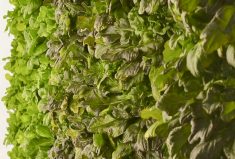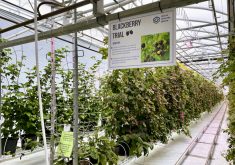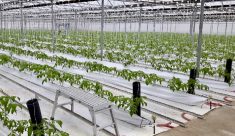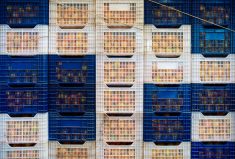Updated Jan. 18, 2021
Municipalities in the major greenhouse-growing area of the province are clamping down on increasingly bright greenhouse lighting making night into day in the rural areas where they operate.
The municipality of Leamington recently enacted a bylaw to stem and roll back light pollution emitted from the region’s sizeable and diverse greenhouse sector.
The Greenhouse Light-Abatement Bylaw, passed during a council meeting on Dec. 8, comes after similar legislation was adopted by the neighbouring municipality of Kingsville in October.
Greeted with praise by many, and enacted after public consultation, the actions have generated pushback from industry.
Read Also

Ontario’s agri-food sector sets sights on future with Agri-Food 2050 initiative
The first-ever Agri Food 2050, a one-day industry event dedicated to envisioning the future of food and farming in Ontario,…
Why it matters: Lighting from greenhouse operations is considered a normal farm practice by the province. Local communities trying to limit light pollution have enacted bylaws in light of no regulation from the province or industry.
The intensity of greenhouse lighting, long a source of contention in both communities, continues to increase as greenhouse developments in both regions proliferate.
The growth of cannabis greenhouses, which require more light than growing vegetables, is also an issue.
The bylaws mandate changes for existing and new greenhouse infrastructure in the form of sidewall and ceiling curtains, or lighting shut-off periods if curtains are not employed during specified hours of the night. Some restrictions on odour emissions targeted at cannabis production facilities are also included. Financial penalties have been set for non-compliance.
Kingsville’s Lighting and Odour Nuisance By-Law, which initially required total, 24-hour coverage, took immediate effect after its acceptance by council on Oct. 26. As described by the municipality in a press release, bylaw enforcement officers are working with greenhouse operators to develop individual plans to attain compliance with respect to light nuisances. Additional outreach to all growers and property owners in this sector is being pursued to provide further awareness and education surrounding the requirements of the bylaw for both light and odour.
Overall, the move was made specifically made to “mitigate nuisances affecting overall enjoyment of property for residents. Enforcement officers are setting short timelines to give growers the opportunity to comply, or provide proof compliance is imminent, before tickets are issued,” the municipality said.

In Leamington, sidewall and end wall curtains must be employed by April 1, 2021. Business owners have until Oct. 1, 2021, to roll out ceiling curtains. Complete ceiling coverage has been mandated, with the exception of a period between 2 a.m. and 6 a.m. when curtains can be opened 10 per cent. In the interim, greenhouses utilizing artificial lighting must turn them off between the hours of 8 p.m. and 2 a.m.
The Ontario Greenhouse Vegetable Growers (OGVG) says it recognizes the legitimate community concerns with greenhouse nighttime glow.
The realities of Canadian winters such as low light levels and temperatures, it said in a statement, mean growers must provide plants with additional light and heat to support growth. It says the sector continues to identify and implement mutually beneficial light control solutions.
“To that end, OGVG has engaged the Ontario Ministry of Agriculture, Food and Rural Affairs (OMAFRA), the University of Windsor, the University of Guelph and Agriculture and Agri-Food Canada to identify lighting strategies and abatement techniques and technologies that can work in the unique climate of southern Ontario.”
Joseph Sbrocchi, general manager of OGVG, says examples of such initiatives include the development of systems to better control humidity and light-generated heat – factors which can negatively affect some crops if proper ventilation is not maintained with curtain systems. Improvements in such areas would thus support lighting control while accounting for different crop growth characteristics.
Industry expected to challenge
As things stand, OGVG also believes the requirements for complete or near-complete coverage is impractical and unenforceable.
Sbrocchi says OGVG had petitioned the municipality of Leamington during the Dec. 8 council meeting to allow the opening of curtains up to 10 per cent, while supplemental lighting is in use. Done on an as-needed basis, he says this would allow for better heat and humidity control.
“We think the greatest majority of farmers would be willing to do 10 per cent as needed,” says Sbrocchi, later adding representatives of cannabis and other production facilities did not participate in the Leamington council meeting where the more stringent coverage policy was adopted.
As things stand, OGVG believes growers may choose not to comply if they feel their crops are being compromised, opting instead to take their chances via legal arbitration.
“You tell me exactly when sunset and sunrise happen at different times every day. Tell me how you police that?” he says. “Nobody knows how to operationalize things better than these growers.”
Sbrocchi adds he does not believe the municipality consulted with the necessary experts in developing the now-adopted bylaw, and that OGVG is focused on the regional situation with an eye on wider province-wide impacts for the greenhouse industry.
Getting ahead of further development
After reviewing OGVG’s response to Leamington’s lighting bylaw, Hilda MacDonald, the municipality’s mayor, says the decision was “not made in a vacuum.” She says equipment suppliers and growers were consulted in addition to the six-week public consultation, which received 1,300 responses from local residents. Nothing was heard from OGVG and the greenhouse sector during that time.
MacDonald adds she believes the decision to regulate at the municipal level should not have been necessary, and regulation from the industry or province would have been much preferred. With neither occurring, and in light of ever-expanding number of acres going under glass, something had to be done.
Further discussions on lighting restrictions on the part of industry will have to be taken up with OMAFRA and the Normal Farm Practices Protection Board.
“When you don’t self regulate you get regulated by the government, whatever level that may be,” says MacDonald.
“I know it isn’t over, but we feel we have defensible point of view. We appreciate the industry. We tried to work with them all along. I have to balance between an entity that affects the majority of residents, and the residents themselves. To me that was the best compromise.”
Problems with lower-tier cannabis production
In Kingsville, mayor Nelson Santos says they are “seeing good movement” from the greenhouse sector in adhering to the jurisdiction’s lighting bylaws. After a meeting with 30 greenhouse growers later in October, the policy has been updated.
Rather than requiring immediate and total coverage, Santos says bylaw enforcement is allowing operations with proof of purchase information for curtains – or those in possession of uninstalled curtains – exemptions from penalty until spring of 2021.
“I think we’re being reasonable and respectful,” says Santos, adding the need for extra venting in some crop production will be taken into consideration in future bylaw amendments.
Significant challenges stemming from lower-tier cannabis production are anticipated, however.
In contrast to large, top-tier production facilities, Santos says those producing plants for individuals with personal medical cannabis licences are closer to the line between legality and criminality, and not as easy to regulate. Many operate in older greenhouses without the capacity to install required curtain systems, for example, and getting consistent adherence to bylaws can already be a challenge.
“There’s such a wide, sparse, experience with some of these growers taking on personal licences to grow for individuals,” Santos says. “How many more hours of policing and special teams do we have to allocate to ensure they’re growing what they’re supposed to be growing? It’s certainly consuming a lot of our time.”
Updated to correct incorrect time.















